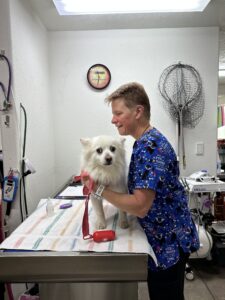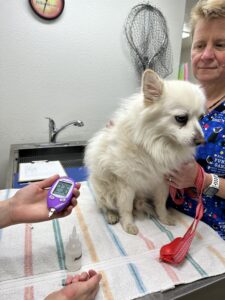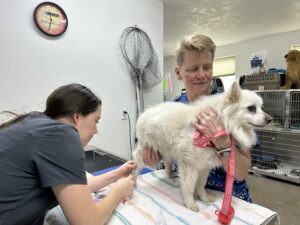 November is Pet Diabetes Month! Read the history of Pet Diabetes Month HERE.
November is Pet Diabetes Month! Read the history of Pet Diabetes Month HERE.
“What is Pet Diabetes? Pets with diabetes cannot produce or utilize insulin properly, preventing the conversion of food to energy.” – USA Pet Diabetes Month
There is no current cure for diabetes but with proper treatment and lifelong care, pets with diabetes can live a long, happy life.
DVM360 states November is an important month because “…awareness is being raised about this lifelong condition affecting approximately 1 in 300 adult dogs and 1 in 230 cats in the United States.”

Signs of Diabetes according to Hepper:
- Increased thirst and water intake (most common sign)
- Increased urination (cats may urinate outside the box)
- Increased appetite (in the early stages)
- Loss of appetite (later stages)
- Weight loss (even though they are eating well)
- Lethargy
- Dehydration
- Cataracts (primarily in dogs)
- Vomiting
Charlie, a 10-year-old American Eskimo Mix, is a current resident of SHS who was diagnosed with diabetes in 2022. He receives insulin injections (subcutaneously) twice daily to help regulate his blood sugar. In addition to the insulin injections, Charlie is on a special diet (Glycobalance Royal Canin) that helps his blood sugar by maintaining healthy blood glucose after a meal.
Charlie was returned to SHS in April of 2023, at this time Charlie’s veterinarian, Dr. Megan, noticed his blood glucose curve was not ideal and his insulin dosage needed to increase. To rule out any other medical concerns, SHS clinic staff also performed a full bloodwork panel (CBC/Chem) which came back normal, other than his glucose levels. They also ordered two Free Style Libre, which are devices that check subcutaneous levels of insulin at any time via the monitoring device once placed on the patient, so they could see if the stress of being in the clinic influenced his levels; however, his levels showed just as high in a comfortable home environment.

On Wednesday November 1st, SHS clinic staff rechecked his blood glucose curve by drawing blood every hour from 8:00am-4:00pm. At the end of the day, SHS clinic staff were able to review the results and determine if Charlie’s increase of insulin improved his glucose levels.
A note from Charlie’s current veterinarian, Dr. Megan: “Blood glucose curves are utilized in veterinary medicine to help assess if the current dose of insulin is working well. Unlike human medicine, we do not check blood glucose immediately before giving the insulin. Typically, blood glucose curves are completed within an 8–10-hour time frame. We check blood glucose levels every hour, and then map out the results of the curve. Ideally, the glucose curve tells us when the insulin starts to work, what the peak of the insulin is and how long the insulin is working. It is important to not increase the amount of insulin too quickly as causing hypoglycemia (too little glucose) is much more serious than hyperglycemia (too much glucose). This can be a slow and progressive process but ultimately will keep Charlie safe as we determine his appropriate insulin dose.”
SHS Clinic Staff completed Charlie’s glucose curve on November 8th, and Dr. Megan happily announced, “it looked the best that it has!” Charlie is now available for adoption.
If you are interested in adopting Charlie, here are a few things about Charlie to get to know him better:
Charlie is a sweet boy who has gotten along with all staff members since arriving at SHS. As you can see, he doesn’t need a muzzle for vet care because he is calm during appointments. However, he does growl and can potentially snap when he is uncomfortable or in pain.
Charlie requires frequent check-ups with his veterinarian to ensure his glucose levels are being controlled. Charlie’s dose of insulin might change overtime and frequent check-ups with his veterinarian will guarantee he is on the correct dose amount.
SHS wants to say a special thank you to Charlie’s foster family who provided dedicated love and support to Charlie throughout his time at SHS. The foster program was an important aspect of Charlie’s care since he needed, and still needs, daily insulin injections. SHS relies heavily on its foster parents to help save thousands of lives and Charlie’s foster family was a key component in helping Charlie. If you are interested in fostering, please click HERE.


